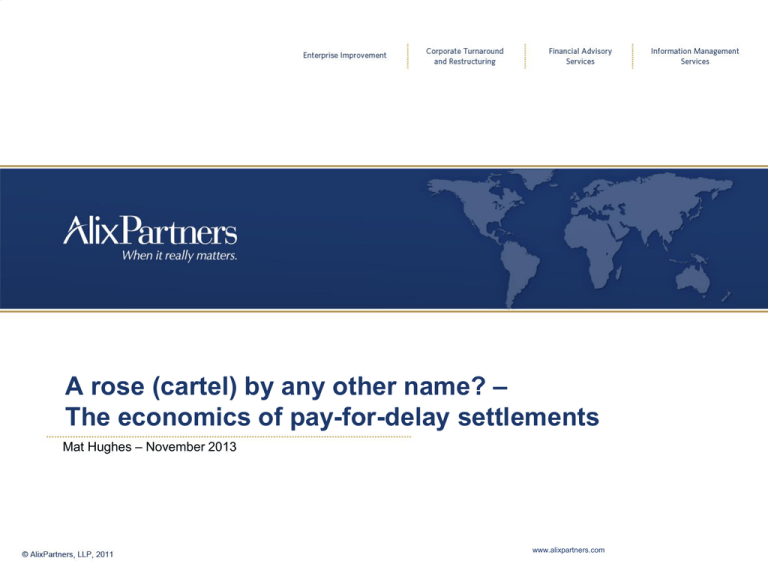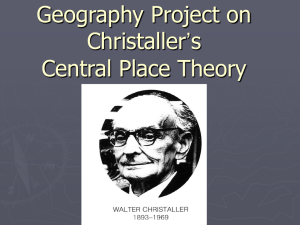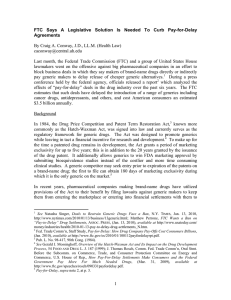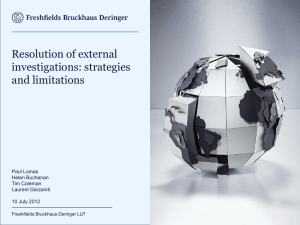The Big Bad Wolf (aka pharmaceutical companies) v Competition
advertisement

A rose (cartel) by any other name? – The economics of pay-for-delay settlements Mat Hughes – November 2013 www.alixpartners.com Contents Economic (I): A (simple) theory of harm Economics (II): Three key questions: 1. 2. 3. Would there still be scope for settlement? Settlement without pay - would entry occur earlier or later? What about incentives to innovate? Conclusions www.alixpartners.com 2 Economics (I): a theory of harm “ Majority opinion of Supreme Court: “An unexplained large reverse payment itself would normally suggest that the patentee has serious doubts about the patent’s survival. And that fact, in turn, suggests that the payment’s objective is to maintain supracompetitive prices to be shared among the patentee and the challenger rather than face what might have been a competitive market—the very anticompetitive consequence that underlies the claim of antitrust unlawfulness.The owner of a particularly valuable patent might contend, of course, that even a small risk of invalidity justifies a large payment. But, be that as it may, the payment (if otherwise unexplained) likely seeks to prevent the risk of competition. And, as we have said, that consequence constitutes the relevant anticompetitive harm. In a word, the size of the unexplained reverse payment can provide a workable surrogate for a patent’s weakness, all without forcing a court to conduct a detailed exploration of the validity of the patent itself” [Emphasis added] www.alixpartners.com 3 Theory of harm (II) Theory of harm: consider incumbent and generic expected profits if there is patent litigation and incentives to reach a pay-for-delay settlement Suppose that: ‒ 70% chance of incumbent winning ‒ Incumbent NPV profits of €100m if no generic entry, but if entry occurs its profits would halve to €50m ‒ Generic firm NPV profits of €20m if it can establish that it does not infringe patent(s) and ‒ Litigation costs for each party €2.5m, and the loser pays 100% of the other side’s costs. I.e. loser incurs total litigation costs of €5m Just an illustration and real life more complex (e.g. risk preferences, generic firm cash constraints, asymmetric information, different assessments of probabilities etc) www.alixpartners.com 4 Theory of harm (III) EV g = 0.3 x 20 + 0.7 x -5 = 2.5. Accordingly: ‒ Entry is attempted and, if successful, industry profits would fall from €100m (incumbent’s profits) to €70m (combined profits post-entry) ‒ Reduction in profits would reflect lower prices, and thus benefits to purchasers Suppose could agree an enforceable pay-for-delay settlement: ‒ Incumbent expected profits EVi = €83.5m (0.7 ×€100m+0.3 ×(€50m-€5m)). So incumbent willing to pay up to €16.5m to preserve monopoly (€100m - €83.5m) ‒ Generic will find it profitable to accept any pay-for-delay offer over €2.5m ‒ €14m settlement window - Illustrates how pay-for-delay agreements can lead to profitable monopoly profit sharing ‒ Unlike a cartel agreement, not vulnerable to the generic firm “cheating” by subsequently entering the market What if too many entrants to buy off? “Putting blood in the water where sharks are always near”? (SC Dissent) Might not be due to Hatch-Waxman Act 180 day exclusivity for first entrant, may still be profitable (see example) and would not observe if not! www.alixpartners.com 5 Settlement? Q1: Scope for settlement? How do you get lawyers to smile for a photo? Simple theory incomplete. Actually need to ask what would happen absent pay-fordelay (counterfactual). Three possibilities: 1. Litigate to the bitter end (BAD/DEPENDS): - Should authorities care about litigation costs? Would you impose a new €5m tax on most profitable drugs.. R&D incentives (Q3)? - Suppose incumbent believes only 10% chance of winning and cannot otherwise settle? - Answer: Litigation (EVi = €50.5m (0.10 ×€100m+0.90 ×(€50m-€5m)) as greater than profits if generic entry of €50m 2. Generic abandons entry. People bluff! NB settlement might also involve entry prepatent expiry (BAD) 3. Settle – entry earlier or later? (DEPENDS) www.alixpartners.com 6 Would entry occur earlier or later? Q2. Third possibility – still settle, but would entry occur earlier or later? Still settle? Growth in settlements and only 11% of patent settlements problematic (EC July 2012 report). Hard to extrapolate – litigate more/less and the existence of some settlements does not reveal if would otherwise settle (when do you fold in poker?) Earlier or later? The clue’s in the name surely? Majority SC opinion observed parties could still settle by agreeing that the generic could enter earlier. This is possible, and would serve consumers’ interests. Indeed, the FTC’s 2010 study indicated that: “Staff analysis of patent settlements restricting generic entry finds that agreements with compensation on average prohibit generic entry for nearly 17 months longer than agreements without payments, where the average is calculated using a weighted average based on sales of the drugs.” www.alixpartners.com 7 Would entry occur earlier or later? (II) Illustrative example easy to reach settlement - €14m settlement window. Window may collapse if can only settle via early entry: ‒ ‒ the incumbent firm loses a substantial sum if entry occurs one year earlier, whereas the generic firm’s profits from non-exclusive entry one year earlier may be small Settlement may be difficult. Generic firm cash constraints, asymmetric information and different assessment of probabilities may all mean that cash payments promote settlement/entry Banning pay-for-delay settlements may substantially narrow scope for settlements. The dissenting opinion of the Supreme Court adds that: “Taking the prospect of settlements off the table—or limiting settlements to an earlier entry date for the generic, which may still be many years in the future—puts a damper on the generic’s expected value going into litigation, and decreases its incentive to sue in the first place. ….it’s a matter of common sense, confirmed by experience, that parties are more likely to settle when they have a broader set of valuable things to trade.” www.alixpartners.com 8 Conclusions Are pay-for-delay agreements really akin to cartels? Professor Sebastian Edwards: Economics is about telling stories, which capture peoples’ imagination. This requires three elements: question; theory; data analysis Theories of harm are important: ‒ ‒ ‒ Make sense (completeness and incentives)? Encompass (competing theories/efficiencies)? What would expect to observe? Facts to look for Facts (should) get in the way of many a good story, including admitting “don’t know”. Cartel stories catch imagination – “ "a pile of $$$" to be shared” (Lundbeck) Any themes in economist jokes? Meet the one law we all agree on Q3. What about incentives to innovate if within scope of patent? Cartels: Very clear line of sight as to their consequences (particularly given damages actions).. No analogies here www.alixpartners.com 9 AlixPartners is ready to field a team of relevant experts whenever and wherever they are needed. Our professionals speak more than 50 languages and have experience in every corner of the world. Call us. We’ll be there when it really matters. © AlixPartners, LLP, 2012 10









